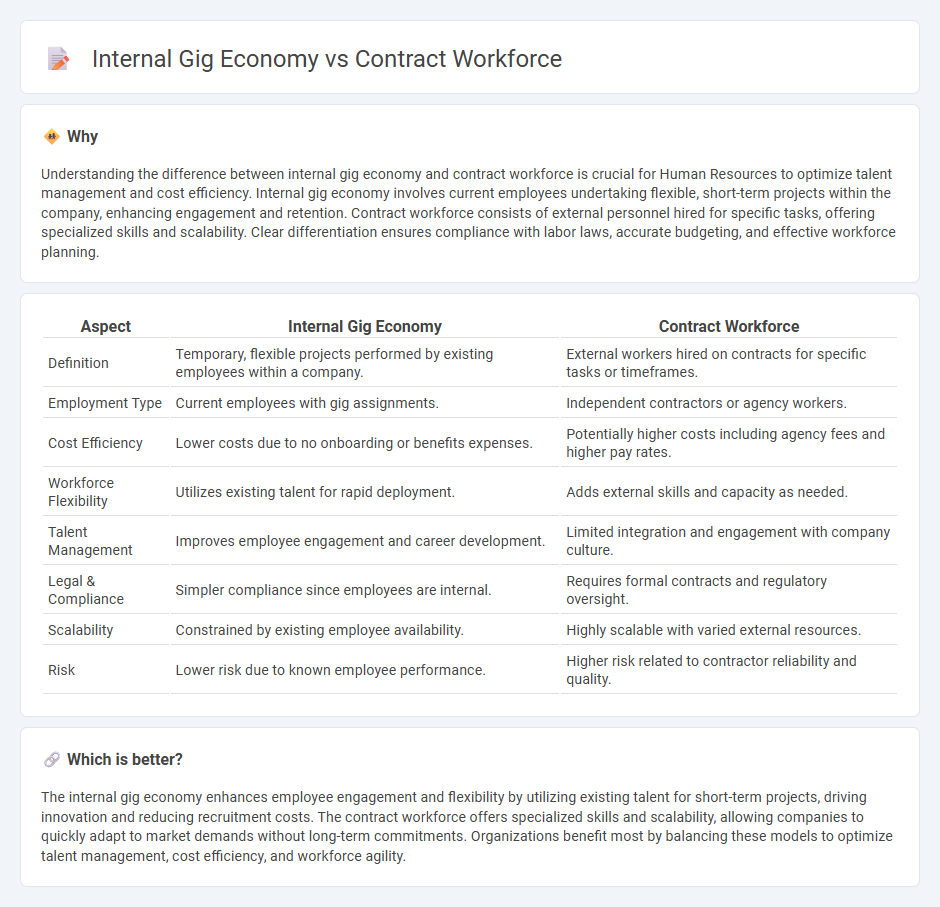
The internal gig economy leverages existing employees for short-term, project-based tasks, enhancing workforce flexibility and employee engagement within the company. Contract workforce consists of external professionals hired for specific roles or projects, providing specialized skills and cost management benefits. Explore how these workforce strategies impact talent management and organizational agility.
Why it is important
Understanding the difference between internal gig economy and contract workforce is crucial for Human Resources to optimize talent management and cost efficiency. Internal gig economy involves current employees undertaking flexible, short-term projects within the company, enhancing engagement and retention. Contract workforce consists of external personnel hired for specific tasks, offering specialized skills and scalability. Clear differentiation ensures compliance with labor laws, accurate budgeting, and effective workforce planning.
Comparison Table
| Aspect | Internal Gig Economy | Contract Workforce |
|---|---|---|
| Definition | Temporary, flexible projects performed by existing employees within a company. | External workers hired on contracts for specific tasks or timeframes. |
| Employment Type | Current employees with gig assignments. | Independent contractors or agency workers. |
| Cost Efficiency | Lower costs due to no onboarding or benefits expenses. | Potentially higher costs including agency fees and higher pay rates. |
| Workforce Flexibility | Utilizes existing talent for rapid deployment. | Adds external skills and capacity as needed. |
| Talent Management | Improves employee engagement and career development. | Limited integration and engagement with company culture. |
| Legal & Compliance | Simpler compliance since employees are internal. | Requires formal contracts and regulatory oversight. |
| Scalability | Constrained by existing employee availability. | Highly scalable with varied external resources. |
| Risk | Lower risk due to known employee performance. | Higher risk related to contractor reliability and quality. |
Which is better?
The internal gig economy enhances employee engagement and flexibility by utilizing existing talent for short-term projects, driving innovation and reducing recruitment costs. The contract workforce offers specialized skills and scalability, allowing companies to quickly adapt to market demands without long-term commitments. Organizations benefit most by balancing these models to optimize talent management, cost efficiency, and workforce agility.
Connection
The internal gig economy and contract workforce are connected through the flexible allocation of talent within organizations, enabling companies to tap into a diverse pool of skills for project-based work without long-term commitments. This approach enhances workforce agility, reduces overhead costs, and supports dynamic staffing models that align with fluctuating business demands. Leveraging internal gig platforms alongside external contract workers fosters a hybrid talent ecosystem, driving innovation and operational efficiency in human resources management.
Key Terms
Employment Status
Contract workforce consists of external professionals hired on a temporary basis with independent contractor status, offering businesses flexibility without the liabilities of full-time employment. Internal gig economy involves existing employees undertaking short-term or project-based tasks within their organization, maintaining their full-time employment status and benefits. Explore more to understand how these models impact workforce management and legal considerations.
Flexibility
Contract workforce offers companies scalability by hiring skilled professionals for specific projects or time frames, enabling rapid adaptation to market fluctuations. Internal gig economy leverages existing employees who undertake short-term, diverse assignments within the organization, fostering agility and retention while maximizing internal talent utilization. Explore how blending these models can enhance workforce flexibility in your business.
Talent Mobility
Contract workforce enables flexible talent acquisition for specific projects, often outside the company's core employee base, whereas internal gig economy leverages existing employees for short-term, cross-departmental assignments, enhancing Talent Mobility within the organization. Internal gig platforms facilitate real-time matching of skills to business needs, promoting employee engagement and retention through diverse experiences. Explore how integrating these models can optimize Talent Mobility strategies in your organization.
Source and External Links
What is a Contract Employee? - This resource provides information on contract employees, including their benefits, hiring processes, and best practices for managing them.
Contingent Workers vs Contract Employees - This article highlights the differences between contingent and contract workers, focusing on job scope, payment, and legal obligations.
The Complete Guide to Contractual Workforce - This guide offers comprehensive insights into the contractual workforce, including its applications and management strategies.
 dowidth.com
dowidth.com